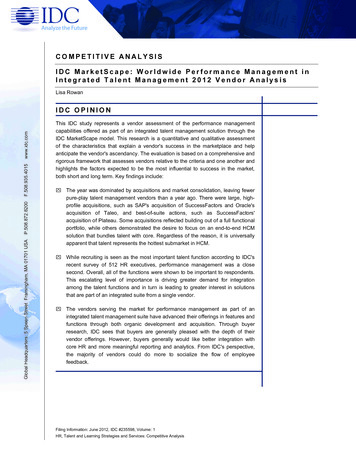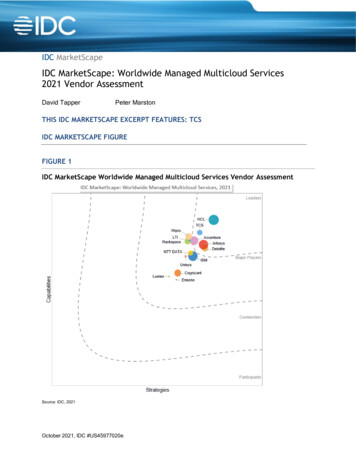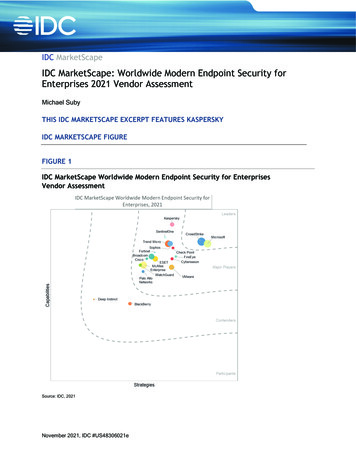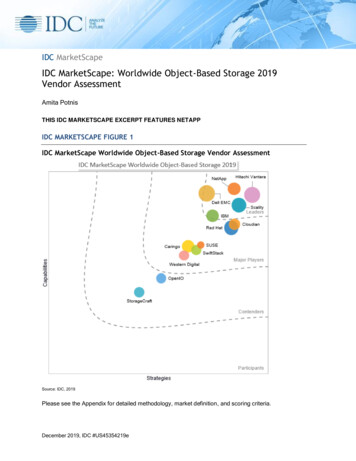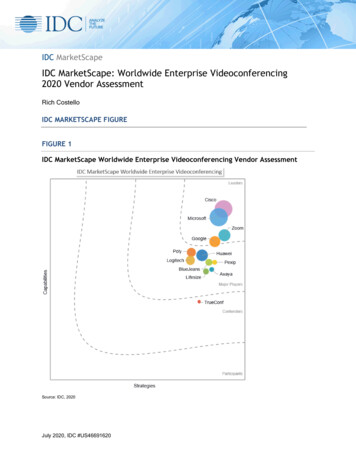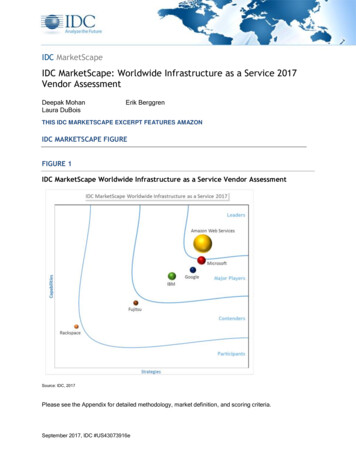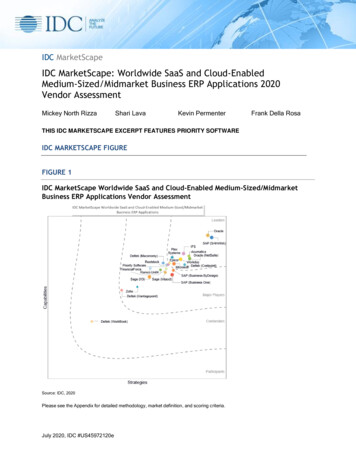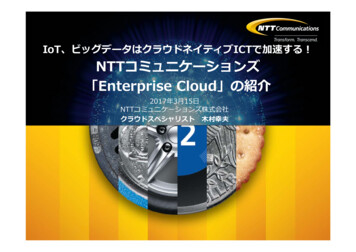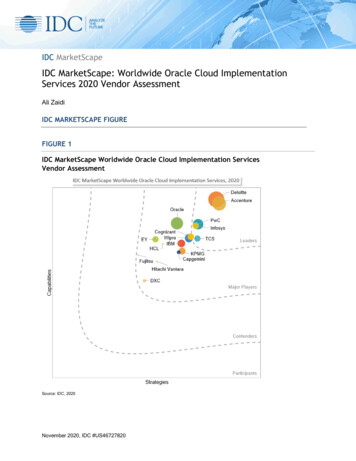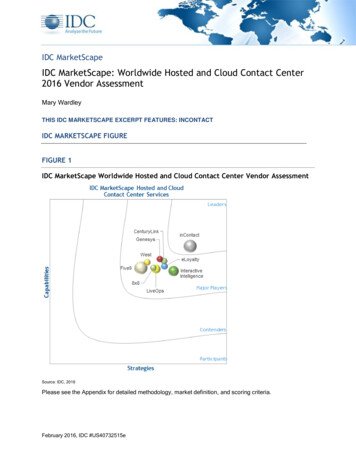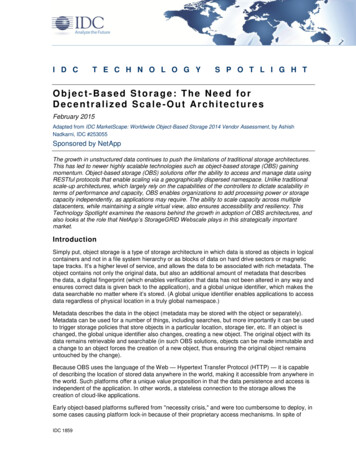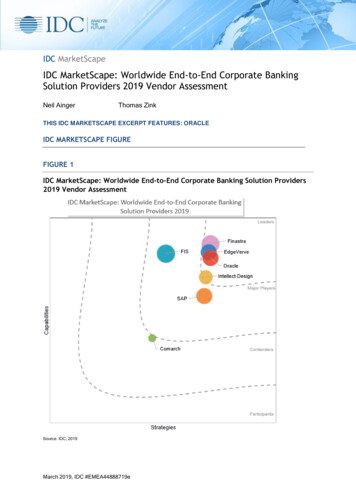
Transcription
IDC MarketScapeIDC MarketScape: Worldwide End-to-End Corporate BankingSolution Providers 2019 Vendor AssessmentNeil AingerThomas ZinkTHIS IDC MARKETSCAPE EXCERPT FEATURES: ORACLEIDC MARKETSCAPE FIGUREFIGURE 1IDC MarketScape: Worldwide End-to-End Corporate Banking Solution Providers2019 Vendor AssessmentSource: IDC, 2019March 2019, IDC #EMEA44888719e
Please see the Appendix for detailed methodology, market definition and scoring criteria.IN THIS EXCERPTThe content for this excerpt was taken directly from IDC MarketScape: Worldwide End-to-EndCorporate Banking Solution Providers 2019 Vendor Assessment (Doc #EMEA44888719). All orparts of the following sections are included in this excerpt: IDC Opinion, IDC MarketScape VendorInclusion Criteria, Essential Guidance, Vendor Summary Profile, Appendix and Learn More. Alsoincluded is Figure 1.IDC OPINIONThis IDC MarketScape assesses seven IT software providers in the corporate banking arenaduring a changing era. Profitability at corporate banks is under threat from niche service providersand because return on equity remains strained. Meanwhile, costs are high due to ongoingregulatory and legacy IT issues. Vendor participants must be able to help corporate banks digitallytransform to meet these challenges and the needs of their clients for a better, more efficient, anddata-centric operation where fees can be charged for value-adding information, rather than justtransactions.An efficient end-to-end (E2E) omni-channel solution provides core bank processing capabilitiesand spans key functions, such as treasury and lending to ensure a good customer experience (CX)and readily accessible data for internal bank clients, is crucial. Ultimately, end-user clients at largemultinational corporations (MNC) or small and medium-sized enterprises (SMEs) want fast,integrated data and services. Only banks that can provide it — with the help of their solutionproviders — will survive the squeeze in this marketplace. Key considerations include: Financial technology (fintech)-enabled newcomers are nibbling away at niche areas oftraditional corporate bank revenue streams, from foreign exchange (FX) to paymentservices and cash management data provision. Banks must respond with better servicesand data to maintain market share — and they are relying on their solution providers tohelp. Ease of integration, core processing strength, platform stability, pricing, proven customerreviews, software support, low risk, scalability, and experience are important elements indelivering everyday capabilities that corporate banks need from such a large investmentheavy solution that can last for decades. Increasingly, E2E capability spanning andintegrating disparate services of a corporate bank from lending to trade finance is a keyselection criterion. This helps efficiency and services, enabling corporate banks tocompete more effectively in the future by knitting together the entirety of their offering. E2E data mastery is vital. It can be powered by properly aligned systems that have allbeen built in-house, systems that have been integrated well after past acquisitions,effective use of Big Data and analytics (BDA), the cloud as a connective layer, applicationprogramming interfaces (APIs) — whether open or not — and many other mechanisms.Banks' key desire is for data-rich information that is readily accessible across the entiretyof their operations. Many will seek to do this themselves, but vendors that can help — or atleast not hinder them with inflexible systems — will be prized more highly than others.Vendors assessed for this research provided detailed responses regarding their currentcapabilities and strategies for the future of E2E corporate banking solutions, so a thorough 2019 IDC#EMEA44888719e2
overview of present-day abilities and future plans is accessible. Client reference calls were alsocarried out.In the near-term, the ability to handle real-time payment (RTP) methodologies and operationaldemands, plus associated liquidity and cash management impacts, and quasi-new standards(such as SWIFT gpi) for cross-border transactions are important new capability metrics. Ultimately,corporate banks are most interested in getting regular software upgrades, security patches,installation assistance, traditional peer advisory councils, learning paths. They also want efficientcore processing capabilities, reconciliation, outsourcing options, and hygiene factors such asadherence to the EU General Data Protection Regulation (GDPR). These are still the mostimportant immediate factors in any purchasing decision. Financial security, regional footprints,growth and so on are also considered in this IDC MarketScape as the investment span for thesesystems is so long.In regard to strategy, the move toward cloud computing and, ultimately, to a banking model that willuse externally-facing open APIs to share comparative data and development opportunities (aseasily as internal APIs have traditionally linked services or provided connectivity in the past) is alsoa key trend; it can also free data. Providers assessed in this IDC MarketScape must be aware ofcloud computing and longer-term open API trends to reassure banks that are thinking about theirneeds three to five years in the future, while still delivering on the crucial everyday capabilities thatare essential for them now.The strategy assessment examines vendors' readiness to meet the data, cloud, and open APIchallenge to established ways of doing business. New business models might include givingcorporate clients dynamic trade pricing, treasury as a service, capital optimization, and other valueadding services. Vendors are also assessed on their ability to incorporate into their road maps newtechnologies such as artificial intelligence (AI), machine learning, and robotic process automation(RPA), which can help efficiency and pattern-spotting for risk mitigation and opportunity services.Innovation labs’ exploration of distributed ledger technology (DLT) and vendors' ability to provideconnectivity options are also explored.This evaluation should be considered as a guide to selection and not as an endorsement of aspecific vendor for any specific engagement. Users will have differing price points, regional,capability, and regulatory or strategic requirements, so the pros and cons of each vendor should beconsidered in the light of individual needs.IDC MARKETSCAPE VENDOR INCLUSION CRITERIAIDC Financial Insights set the following inclusion criteria for this research: A core processing capability (e.g., loan/deposit processing, general ledger) Business systems, including at least three out of four functions: trade finance, cashmanagement and corporate treasury services, commercial lending, and payments. A frontline offering, including at least three out of four channel types: digital channels (e.g.,mobile, online), physical channels (e.g., branch), corporate-to-bank channels (e.g., host-tohost connectivity) and support, and network connectivity (e.g., SWIFT for corporates) A middle-office offering, including at least three out of five systems: risk management (e.g.,credit risk, liquidity risk and market risk); compliance management; business intelligence;operational intelligence, and customer intelligence Above 50 million in estimated total revenues in the worldwide financial services marketfor calendar year 2017–2018 2019 IDC#EMEA44888719e3
Delivery of corporate banking solutions to banking organizations worldwide, meaningvendors have active customers in at least two of the major world regions: North America,Europe and Asia PacificIDC identified that the following companies met these criteria: Comarch, EdgeVerve, Finastra, FIS,Intellect Design, Oracle, and SAP. They are compared in this document. Numerous vendors wereinvited to provide information to participate in this study. However, not all made it to the final list.ADVICE FOR TECHNOLOGY BUYERSThe best E2E corporate banking solution providers must be able to provide a spectrum ofcapabilities. However, purchasing decision-makers should think about the following issues: Identify key functions. Is trade finance expertise more important than payments,commercial lending, or treasury services? What segments do you want to prioritize, or arethey all equally relevant? Bare-minimum functionality is needed to qualify as an E2Eprovider, but does it matter to you as the buyer if that functionality is via a plug-in from apartner vendor or if it is in-house? Does it matter to you if a vendor is particularly strong inone area over another? Vendor profiles in this study outline the strengths and weaknessesof each participant. Evaluate data capabilities. The ability to exchange data across the separate payment,lending, treasury and trade finance functions of a corporate bank is important. This is whyIDC evaluates vendors that built their capabilities from scratch in an agile fashion, thosewith a history of acquisition, as well as how effective their internal integration efforts havebeen, and so on. Assess service and delivery options. Do you want cloud-delivered or on-premisesolutions? Technology buyers should consider what their needs will be in 10 years, and ifthe solution can scale up or down to meet them. Locking in costs with inflexible systems isundesirable, but equally it's a risk moving to new delivery models that require a lot ofgroundwork. Integrate advantage. How vital is installation support, the use of standards (such as ISO20022), advice from peers, hygiene factors (such as built-in SWIFT connectivity), andcompliance assistance to you? The purpose of specifying an E2E solution is to take someof the burden of linking it all together off the bank, so look at vendors' existing capabilitiesin this area and their future plans in regard to financial utilities and so on. Futureproof your system. Focus on flexibility and vendors' future integration capabilities,as outlined in their technology road maps. The approach to the cloud and open APIs,ecosystems. and interoperability with evolving DLT platforms, data lakes, and so on is notas important now, but it will be over the long life span of these expensive solutions. Master the data deluge. A key trend to note is the nexus between in-memory databasesand data systems, provided by vendors such as SAP and Oracle, which can free data fromsilos and help deliver fast new value-adding services. However, SAP must further developits functional trade finance capabilities and align them with its new SAP S/4HANA Cloudoffering. Oracle has its long-established FLEXCUBE core, but could be better on risk intreasury. Neither should it discount the ability of large incumbents such as FIS andFinastra to improve their own data, cloud, and E2E analytical capabilities. They areworking on these areas to maintain their entrenched positions, which are buttressed bylong-standing clients on valuable recurring on-premise contracts. FIS has a lot of paymentprocessor contracts in the U.S., which give it the revenue stream and base to monitor andreact to developing trends with scale. Conquer the cloud. Vendors' cloud strategies are important in the near-term as they couldhelp corporate banks cater more easily to changes in the marketplace, driven by client 2019 IDC#EMEA44888719e4
demands for a fast 24 x 7, multidevice service. Effective use of the cloud could also reduceoperating costs at most corporate banks. Assess the ability to partner. E2E vendors should be able to deliver a comprehensive endto-end service and partner. This can be in the form of co-creation with the bank or avendor's ability to collaborate with the wider banking ecosystem that involves fintechs,standards-setting bodies, regulators, and other industries. The connected bank of thefuture should be able to swap in and out new products or services developed by fintechpartners that better serve the needs of their clients. This could mean a corporate bankpartners with a crowdfunder on SME lending and focuses on MNCs for internaldevelopmental efforts or puts together a services platform to ensure client lock-in. Theunderlying system a bank uses must be flexible enough to accommodate such trends.Internal APIs and traditional methods of data exchange already provide much-needed connectivityand applications in this sector, and cloud is slowly delivering different apps and capabilities toovercome legacy IT systems and silos that previously blocked the free flow of information andimpeded user experiences (UX). Many vendors are actively making their solutions cloud-ready,hostable on their platforms or external parties (such as AWS), and are growing cloud as part oftheir revenue mix. But it's a slow process; traditional architectures are still prevalent in corporatebanking for the time being.In the longer term, open APIs can spur easier connectivity and innovative data-based servicesfrom start-ups that will use the ability to aggregate and interrogate newly opened customer datastreams (which no longer "belong" to the bank) to offer new price or service comparisons. This zealcan be harnessed by established vendors and banks if they are set up to take advantage of thenew operating models that will eventually emerge and are prepared to develop ecosystems andplatforms that prioritize services over proprietary methodologies.Client end users in the treasury or finance functions of MNCs or SMEs have come to expect fastintegrated service in their work lives — just like what they experience at home when using socialmedia, online systems and connected devices. This places new CX demands on vendorssupplying banks, which they haven't previously faced.VENDOR SUMMARY PROFILESThis section briefly explains IDC’s key observations resulting in a vendor's position in this IDCMarketScape. While every vendor is evaluated against each criterion outlined in the Appendix, thedescription here summarizes each vendor’s strengths and challenges.OracleOracle, whose key product offering is its FLEXCUBE suite, is positioned as a Leader in this IDCMarketScape.Oracle Financial Services Software Limited (OFSS) is an Indian-based subsidiary of the AmericanOracle Corporation. Its Oracle for Corporate Banking solution is a mixture of its FLEXCUBEproduct for core bank processing, combined with liquidity management, corporate lending,payment, mandate management, and other modules, such as Islamic banking. These can beadded to suit client needs, alongside cloud, outsourced managed service options, and Oracle'sdata management and analytical capabilities. It is present in 140 countries around the world, withoffices, partners, datacenters, and other facilities spanning its key EMEA, APAC, and Americasmarkets.Its clients include Mashreq Bank, Rabobank, Wells Fargo, Citibank, and Banque Misr, amongothers. It has three dedicated R&D centers at Bangalore, Mumbai, and Chennai, and 12 global 2019 IDC#EMEA44888719e5
centers of excellence, plus a partner network around the world, a clear API strategy, and otheradvantages. It is strong on the back end and databases, as you would expect with its history andJava knowledge. However, it still requires occasional assistance in customer-facing front-end toolsin treasury.StrengthsOracle stood out in the E2E and data analytical categories that are highly valued in this IDCMarketScape. Its history of relational database expertise and ability to integrate past acquisitionsmean that it can provide the comprehensive solution and data capabilities sought by end users.Oracle is positioned well to create deeper functional links and services. It has launched anecosystem marketplace and does hackathons.The addition of a virtual account and liquidity management module, Islamic banking certification,and so on round out its offering. It also includes new process management modules designed tobetter handle workflows on corporate lending, credit, and trade finance. Oracle's technology roadmap stretches to include AI, machine learning, and blockchain connectivity via an adapter. Thealignment of real-time payments and data should suit it. Its cloud service is a focus area. However,the strength of the Azure and AWS hosting platforms have traditionally made it difficult for Oracleto advance its own offering in that particular subset.ChallengesThe use of customer-facing front-end tools from selected partners for treasury and risk data couldbe seen as a weakness to be addressed by developing an in-house capability. However, it iscommon in this field to partner — for example, to get automated FX or financial market data — anddoes round out its offering.As with all large incumbent players, Oracle hopes to remain relevant via its marketplace of cooperative fintechs and others that aren't directly competitive, but there is room for growth. Oraclewants co-operation with smaller players to ensure end users get the service they want from them,rather than go elsewhere; this is in line with other large rivals. Time will tell how successful itsmarketplace and strategy will be in this regard, but its direction is clear, well laid out, and in linewith trends in the sector.Consider Oracle WhenConsider Oracle when you want a provider with E2E and data analytical capabilities acrosssegments and extensive global reach.APPENDIXReading an IDC MarketScape GraphFor the purposes of this analysis, IDC divided potential key measures for success into two primarycategories: capabilities and strategies.Positioning on the y-axis reflects the vendor’s current capabilities and menu of services and howwell aligned the vendor is to customer needs. The capabilities category focuses on the abilities ofthe company and product today. Under this category, IDC analysts will look at how well a vendor isbuilding/delivering capabilities that enable it to serve users well.Positioning on the x-axis or strategies axis indicates how well the vendor's future strategy alignswith what customers will require in three to five years. The strategies category focuses on high- 2019 IDC#EMEA44888719e6
level decisions and underlying assumptions about offerings, customer segments, and businessand go-to-market plans for the next three to five years.The size of the individual vendor markers in this IDC MarketScape represent IDC FinancialInsights’ best estimate of the vendor’s worldwide corporate banking revenue streams. This isdistinct from its general financial services (FS), general banking, or other revenue streams. Thevendor’s bubble sizes are based on information directly supplied in the Request for Information(RFI) accompanying this IDC MarketScape or via specific percentage figures supplied forcorporate banking’s worth in the vendor’s revenue streams. Alternatively, a combination of thecompany’s publicly available financial accounting data, customer numbers, market knowledgeabout the size of those clients, and other sources of information are used to obtain a revenue figureand representation of the company position in the marketplace.IDC notes that the E2E corporate banking solution marketplace is relatively new, so the installedbase is also "new." Vendors did not previously package their disparate offerings as an E2Esolution. This accounts for the similarly in size of the bubble sizes. As the market for thecomprehensive E2E corporate banking solution set develops, IDC expects to see the bubble sizesdrift further apart in later assessments. Those providing the key functionality needed — acrosstreasury, payments, lending, and trade finance, plus associated core processing capabilities anddata analytics — will naturally divide into winners and losers.IDC MarketScape MethodologyIDC MarketScape criteria selection, weightings, and vendor scores represent well-researched IDCjudgment about the market and specific vendors. IDC analysts tailor the range of standardcharacteristics by which vendors are measured through structured discussions, surveys, andinterviews with market leaders, participants and end users. Market weightings are based on userinterviews, buyer surveys and the input of IDC experts in each market. IDC analysts baseindividual vendor scores — and ultimately, vendor positions on this IDC MarketScape — on detailedsurveys and interviews with the vendors, publicly available information and end-user experiencesto provide an accurate and consistent assessment of each vendor's characteristics, behavior andcapability.Note that all numbers in this document may not be exact due to rounding.IDC understands the difficulty in making three client references available for the one-to-one IDCMarketScape evaluation with them. However, the ability to provide relevant references of sufficientnumber that we can then interview to gain a perspective on the provider’s capabilities, positivelyinfluences the evaluation against the provider’s peers. IDC analysts will endeavor to do their ownend user interviews when references are not supplied.Market DefinitionThis IDC study assesses the capabilities and strategies of IT software vendors in supportingcorporate banking organizations around the world to digitally transform their enterprises byenabling a customer-centric, flexible, scalable, and efficient end-to-end (E2E) solution. Theevaluation looks at select vendors' ability to provide the entire range of corporate banking systemsspanning core banking capabilities, multiple channels, and functions such as trade finance, cashmanagement and treasury services, payments, and commercial lending. It also considers theproviders' ability to provide data across these segments and collaborate with the wider bankingecosystem that involves fintechs, academia, and other industries.The corporate banking solution area is distinct from retail bank provision as it must necessarilycover commercial lending and other such functions. However, most vendors span the two fields, 2019 IDC#EMEA44888719e7
offering specialist corporate modules added to core processing capabilities. Historically, thecorporate bank was the last to get online, mobile, or advanced technological solutions, behindretail or investment banks. But this is changing as newcomers offering specialist niche lending, FXmitigation capabilities, and risk tools traditionally associated with a corporate bank eat away atmarket share in niche areas. Enhancing efficiency and better aligning services with customerexpectations of a fast, 24 x 7 digital service to address the need to improve corporate banks'profitability are also key drivers in this marketplace, which has slowly woken up to the need forchange.The long lifespan of E2E corporate banking solutions means that assessing providers' futurestrategy plans and technology road maps is as important as their present capabilities.Consequentially, both are weighted on a 50/50 basis. However, the ability to provide ease ofintegration, core processing strength, platform stability, pricing, software support, low risk, andmultichannel/multifunctional capabilities here and now was a key consideration for clients duringthe end-user bank interview process.Providers' ability to span and integrate disparate services of a corporate bank from lending to tradefinance functions, while ensuring data can roam free and analytical tools can mine information topower value-adding services, was a key requirement in this IDC MarketScape. The ability toconsume external Big Data and analytics (BDA) from unstructured sources was important in thisregard. Most end users don’t care yet if solution providers use internal APIs, traditional dataexchange methodologies, the cloud, or open APIs to power data tools, but they will. There is afeeling among the seven vendors assessed that they must accelerate their cloud offerings and planfor an ecosystem of open API-enabled data tools in the future.LEARN MORERelated Research Interoperable Instant Payments and Liquidity: Why Limits Need to Rise, Data Align, andCorporate Use Cases Evolve (IDC #EMEA44442418, November 2018) IDC FutureScape: Worldwide Corporate Banking 2019 Predictions (IDC #EMEA44384418,October 2018) IDC FutureScape: Worldwide Payments 2019 Predictions (IDC #US43348718, October2018) IDC FutureScape: Worldwide Financial Services 2019 Predictions (IDC #US43052618,October 2018) IDC FutureScape: Worldwide Intelligent ERP 2019 Predictions (IDC #US43262918,October 2018) IDC's Worldwide Digital Transformation Use Case Taxonomy, 2018: Finance (IDC#US44247318, September 2018) Worldwide Big Data and Analytics Software Forecast, 2018-2022 (IDC #US44243318,September 2018) SWIFT gpi: Cross-Border Payment Tracking, Data, and DLT - Enough to Save theNetwork? (IDC #EMEA44203218, August 2018)SynopsisThis IDC MarketScape assesses seven IT software providers offering end-to-end solutions tocorporate banks, spanning channels, their core processing needs, and functional capabilities fromtreasury to lending in a convenient package. The solution should deliver ease of integration,connectivity — whether using traditional internal APIs or open APIs to encourage data sharing, 2019 IDC#EMEA44888719e8
comparisons, and developmental work — and hygiene factors such as adherence to the latestregulations and installation assistance. Delivery models can range from a traditional on-premise ormanaged solution through to the cloud, and service should be backed by regular softwareupgrades, security patches, and flexibility to pivot to meet new demands as they arise.The ability to free data across the functional silos of a corporate bank from payments to tradefinance — enabling new efficiencies and analytical services, alerts, and business models to emerge— is especially prized. Digital transformation (DX) to improve efficiency, end-user experiences, andflexibility is assessed alongside solution providers' stability, geographic footprints, track records,and technology road maps. A core banking solution at a corporate bank could last decades, sovendors' plans to accommodate new technologies such as AI, open API-enabled ecosystems, anddistributed ledger technology (DLT) connectivity options are assessed as part of a futureproofingmethodology.This research is a quantitative and qualitative assessment of characteristics that explain a vendor'sability to deliver a comprehensive solution. The evaluation is based on a standardized, extensiveframework of questions examining functional present capabilities and future strategy. Vendor callsand standalone corporate bank end user interviews are included in the process. General marketperception and technology buyers' views about a vendor's current capabilities, pros and cons, andits attitude toward innovation are important components in this evaluation."Opportunities to integrate various functions of corporate banks more coherently using an end-toend (E2E) corporate banking solution that spans channels, processing needs and functions in aconvenient package are self-evident. This packaged way of presenting connected solutions withdata to the fore is a relatively new phenomenon," said Neil Ainger, research manager for worldwidecorporate banking, IDC Financial Insights. "The capabilities have always existed, but E2E solutionshelp banks link together its services more efficiently. These solutions also enable banks to digitallytransform operations and prepare for cloud, more open API usage, and the development ofecosystems packed with various providers, should they so wish.“E2E data mastery delivers easy compliance, automation, and onboarding capabilities, plus riskhedging and spotting capabilities that bank clients can utilize. As revenues fall and fintech-inspiredcompetition rises, corporate banks need new revenue streams. Well-aligned payment, cashmanagement, liquidity, asset and supply chain alerts, lending data that can tap unstructured datasources, among others, can improve banks' chances of success. Many banks will develop suchdata-centric services themselves, but solutions that offer them co-creation or partner options — orat the least do not hinder their internal developmental efforts with inflexible software — will be highlyprized. Reduced operating costs and enhanced functional capabilities that are better integrated arealso beneficial." 2019 IDC#EMEA44888719e9
About IDCInternational Data Corporation (IDC) is the premier global provider of market intelligence, advisoryservices, and events for the information technology, telecommunications and consumer technologymarkets. IDC helps IT professionals, business executives, and the investment community makefact-based decisions on technology purchases and business strategy. More than 1,100 IDCanalysts provide global, regional, and local expertise on technology and industry opportunities andtrends in over 110 countries worldwide. For 50 years, IDC has provided strategic insights to helpour clients achieve their key business objectives. IDC is a subsidiary of IDG, the world's leadingtechnology media, research, and events company.IDC U.K.IDC UK5th Floor, Ealing Cross,85 Uxbridge RoadLondonW5 5TH, United Kingdom44.208.987.7100Twitter: @IDCidc-community.comwww.idc.comCopyright and Trademark NoticeThis IDC research document was published as part of an IDC continuous intelligence service, providingwritten research, analyst interactions, telebriefings, and conferences. Visit www.idc.com to learn more aboutIDC subscription and consulting services. To view a list of IDC offices worldwide, visit www.idc.com/offices.Please contact the IDC Hotline at 800.343.4952, ext. 7988 (or 1.508.988.7988) or sales@idc.com forinformation on applying the price of this document toward the purchase of an IDC service or for information onadditional copies or web rights. IDC and IDC MarketScape are trademarks of International Data Group, Inc.Copyright 2019 IDC. Reproduction is forbidden unless authorized. All rights reserved.
Its Oracle for Corporate Banking solution is a mixture of its FLEXCUBE product for core bank processing, combined with liquidity management, corporate lending, payment, mandate management, and other modules, such as Islamic banking. These can be added to suit client needs, alongside cloud, outsourced managed service options, and Oracle's
